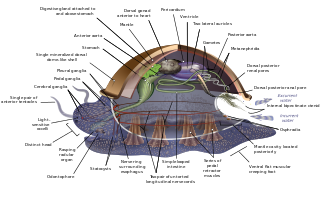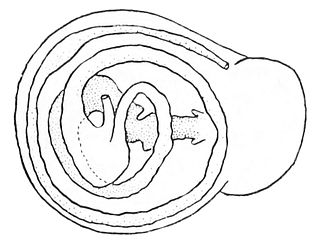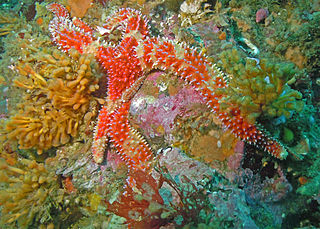
Digestion is the breakdown of large insoluble food compounds into small water-soluble components so that they can be absorbed into the blood plasma. In certain organisms, these smaller substances are absorbed through the small intestine into the blood stream. Digestion is a form of catabolism that is often divided into two processes based on how food is broken down: mechanical and chemical digestion. The term mechanical digestion refers to the physical breakdown of large pieces of food into smaller pieces which can subsequently be accessed by digestive enzymes. Mechanical digestion takes place in the mouth through mastication and in the small intestine through segmentation contractions. In chemical digestion, enzymes break down food into the small compounds that the body can use.

Bivalvia, in previous centuries referred to as the Lamellibranchiata and Pelecypoda, is a class of marine and freshwater molluscs that have laterally compressed bodies enclosed by a shell consisting of two hinged parts. As a group, bivalves have no head and they lack some usual molluscan organs, like the radula and the odontophore. The class includes the clams, oysters, cockles, mussels, scallops, and numerous other families that live in saltwater, as well as a number of families that live in freshwater. The majority are filter feeders. The gills have evolved into ctenidia, specialised organs for feeding and breathing. Most bivalves bury themselves in sediment, where they are relatively safe from predation. Others lie on the sea floor or attach themselves to rocks or other hard surfaces. Some bivalves, such as the scallops and file shells, can swim. Shipworms bore into wood, clay, or stone and live inside these substances.

A siphon is an anatomical structure which is part of the body of aquatic molluscs in three classes: Gastropoda, Bivalvia and Cephalopoda.

The tusk shells or tooth shells, technically the Scaphopoda, are members of a class of shelled marine mollusc with worldwide distribution, and are the only class of exclusively infaunal marine molluscs. Shells of species within this class range from about 0.5 to 18 cm in length. Members of the order Dentaliida tend to be larger than those of the order Gadilida.

Teredo navalis, commonly called the naval shipworm or turu, is a species of saltwater clam, a marine bivalve mollusc in the family Teredinidae. This species is the type species of the genus Teredo. Like other species in this family, this bivalve is called a shipworm because it resembles a worm in general appearance while at the anterior end it has a small shell with two valves, and it is adept at boring through wood.

The evolution of the molluscs is the way in which the Mollusca, one of the largest groups of invertebrate animals, evolved. This phylum includes gastropods, bivalves, scaphopods, cephalopods, and several other groups. The fossil record of mollusks is relatively complete, and they are well represented in most fossil-bearing marine strata. Very early organisms which have dubiously been compared to molluscs include Kimberella and Odontogriphus.
A molluscivore is a carnivorous animal that specialises in feeding on molluscs such as gastropods, bivalves, brachiopods and cephalopods. Known molluscivores include numerous predatory molluscs,, arthropods such as crabs and firefly larvae, and, vertebrates such as fish, birds and mammals. Molluscivory is performed in a variety ways with some animals highly adapted to this method of feeding behaviour. A similar behaviour, durophagy, describes the feeding of animals that consume hard-shelled or exoskeleton bearing organisms, such as corals, shelled molluscs, or crabs.
Freshwater bivalves are one kind of freshwater mollusc, along with freshwater snails. They are bivalves that live in fresh water as opposed to salt water, which is the main habitat type for bivalves.

The common starfish, common sea star or sugar starfish is the most common and familiar starfish in the north-east Atlantic. Belonging to the family Asteriidae, it has five arms and usually grows to between 10–30 cm across, although larger specimens are known. The common starfish is usually orange or brownish in color, and sometimes violet; specimens found in deeper waters are pale. The common starfish is found on rocky and gravelly substrates where it feeds on mollusks and other benthic invertebrates.

The ocean quahog is a species of edible clam, a marine bivalve mollusk in the family Arcticidae. This species is native to the North Atlantic Ocean, and it is harvested commercially as a food source. This species is also known by a number of different common names, including Icelandic cyprine, mahogany clam, mahogany quahog, black quahog, and black clam.
A valve is each articulating part of the shell of a mollusc or another multi-shelled animal such as brachiopods and some crustaceans. Each part is known as a valve or in the case of chitons, a "plate". Members of two classes of molluscs, the Bivalvia (clams) and the Polyplacophora (chitons), have valves.

A bivalve shell is part of the body, the exoskeleton or shell, of a bivalve mollusk. In life, the shell of this class of mollusks is composed of two hinged parts or valves. Bivalves are very common in essentially all aquatic locales, including saltwater, brackish water, and freshwater. The shells of bivalves commonly wash up on beaches and along the edges of lakes, rivers, and streams. Bivalves by definition possess two shells or valves, a "right valve" and a "left valve", that are joined by a ligament. The two valves usually articulate with one another using structures known as "teeth" which are situated along the hinge line. In many bivalve shells, the two valves are symmetrical along the hinge line—when truly symmetrical, such an animal is said to be equivalved; if the valves vary from each other in size or shape, inequivalved. If symmetrical front-to-back, the valves are said to be equilateral, and are otherwise considered inequilateral.

The molluscshell is typically a calcareous exoskeleton which encloses, supports and protects the soft parts of an animal in the phylum Mollusca, which includes snails, clams, tusk shells, and several other classes. Not all shelled molluscs live in the sea; many live on the land and in freshwater.

Mollusca is the second-largest phylum of invertebrate animals, after the Arthropoda; members are known as molluscs or mollusks. Around 85,000 extant species of molluscs are recognized. The number of fossil species is estimated between 60,000 and 100,000 additional species. The proportion of undescribed species is very high. Many taxa remain poorly studied.

The digestive system of gastropods has evolved to suit almost every kind of diet and feeding behavior. Gastropods as the largest taxonomic class of the mollusca are very diverse: the group includes carnivores, herbivores, scavengers, filter feeders, and even parasites.

Divaricella quadrisulcata, or the cross-hatched lucine, is a species of marine bivalve mollusc in the family Lucinidae. D. quadrisulcata, also known as Divalinga quadrisulcata, are known for their unique shell patterns. The shells of D. quadrisulcata have been used as jewelry and can be collected along the shore in many Atlantic coastal states in North America. These organisms are known to have a symbiotic relationship with sulfur-oxidizing bacteria, as is characteristic of many other organisms within the family Lucinidae.
Entovalva nhatrangensis is a species of small marine bivalve mollusc in the family Lasaeidae. It was first described in 2010 and its specific name "nhatrangensis" derives from the locality where it was originally found, Nha Trang Bay in Vietnam. It lives inside the oesophagus of certain species of sea cucumbers. It is considered to be an endosymbiont rather than a parasite because it does not harm its host.

Evasterias troschelii is a species of starfish in the family Asteriidae. Its common names include the mottled star, false ochre sea star and Troschel's true star. It is found in Kamchatka and the north western coast of North America.

Orthasterias is a genus of sea stars in the family Asteriidae. Orthasterias koehleri, the rainbow star or red-banded sea star, is the only species in the genus. It is found in the North Pacific Ocean.
A gastric shield is an organ in the digestive tract of bivalves, tusk shells, and some gastropods against which a crystalline style typically rotates, in an action resembling that of a mortar and pestle. The gastric shield is permeated by microcanals which transmit digestive enzymes from the stomach, and serves to protect the cells of the stomach lining from the abrasive effects of the style.

















